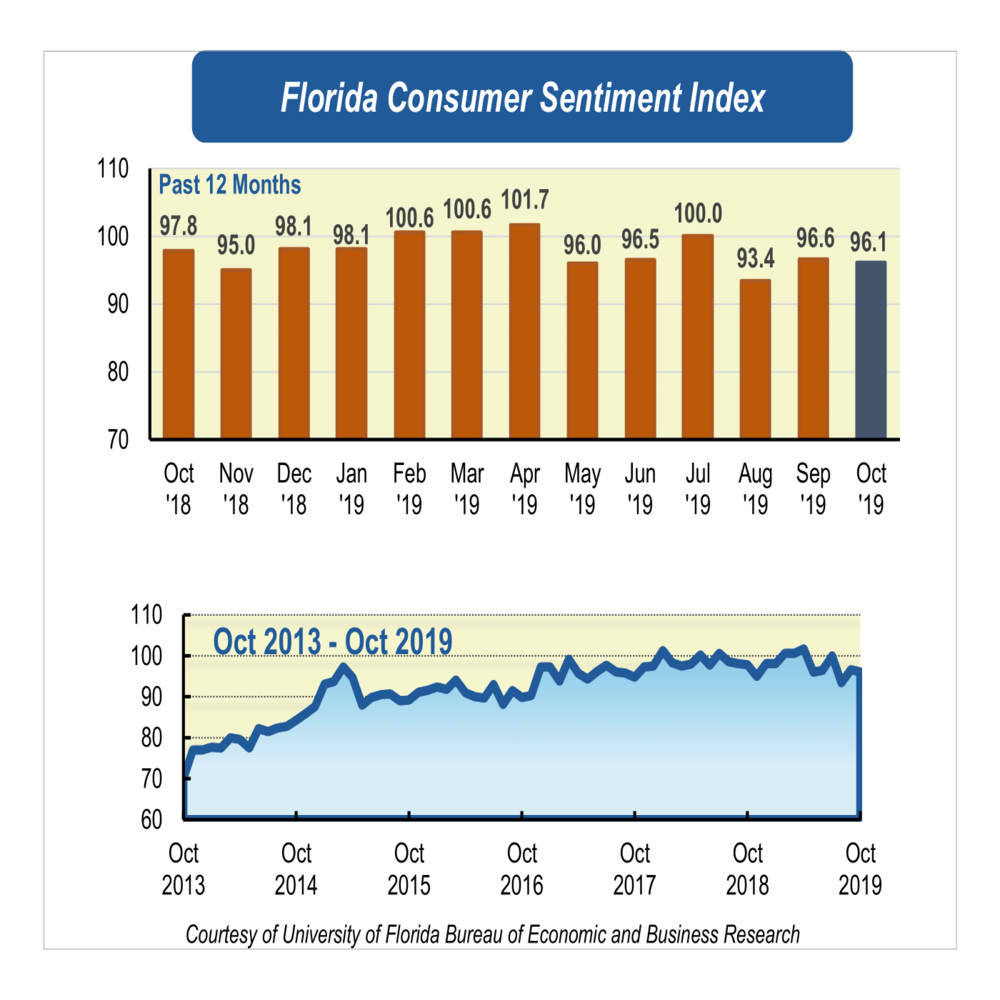
October’s consumer sentiment holds steady leading up to holiday season
Consumer sentiment among Floridians decreased five-tenths of a point to 96.1 in October from a revised figure of 96.6 in September.
Of the five components that make up the index, four decreased and one increased.
Floridians’ feelings toward current economic conditions were mixed. Opinions of personal financial situations now compared with a year ago increased 7.3 points from 85.4 to 92.7, the greatest increase for any reading this month. Notably, this perception is shared by all Floridians across sociodemographic groups but is particularly stronger among women and those age 60 and older.
Opinions as to whether now is a good time to buy a major household item such as an appliance showed a decline in this month’s reading from 103.4 to 102.3 a change of 1.1 points. Two groups, however, report a small favorable change: men and those with annual income under $50,000.
“Even though these two components moved in opposite directions, together they showed that opinions regarding current economic conditions improved among Floridians in October. This improvement is consistent with Florida’s economic outlook,” said Hector H. Sandoval, director of the Economic Analysis Program at UF’s Bureau of Economic and Business Research.
The three components representing future economic conditions showed a more pessimistic outlook in October. Expectations of personal financial situations a year from now dropped slightly, seven-tenths of a point, from 104.9 to 104.2. The outlook of U.S. economic conditions over the next year decreased 5.9 points from 96.3 to 90.4. Finally, expectations of U.S. economic conditions over the next five years declined 1.8 points from 92.8 to 91.
“Opinions are divided across sociodemographic groups regarding Floridians’ expected financial situation as well as views about the U.S economic situation in the long-run. The pessimistic views about the short-term outlook on the U.S. economy, however, are shared by all Floridians and are particularly stronger among women, those age 60 and older, and those with income levels above $50,000,” Sandoval said.
Florida’s economic conditions remain favorable with more jobs added this month and further declines in the unemployment rate. According to the latest report, the state gained 224,700 jobs compared with a year ago, an increase of 2.5%. Among all industries, education and health services gained the most jobs, followed by professional and business services and leisure and hospitality. The only industry losing jobs over the year was information. The unemployment rate decreased one-tenth of a percentage point from 3.3% in August to 3.2% in September and approached the historical observed minimum of 3.1% in March 2006.
“Despite the slightly decreased and pessimistic outlook about future economic conditions, consumer sentiment continues to be high in Florida, and unemployment levels are currently at their lowest since July 2006. These indicators are positive signs for retailers, who can expect more spending during the holiday shopping season,” Sandoval said.
Indeed, as the end-of-year shopping season begins, the National Retail Federation has forecast that holiday retail sales in November and December will increase between 3.8% and 4.2% from last year.
Conducted October 1-24, the UF study reflects the responses of 482 individuals who were reached on cellphones, representing a demographic cross section of Florida. The index used by UF researchers is benchmarked to 1966, which means a value of 100 represents the same level of confidence for that year. The lowest index possible is a 2, the highest is 150.
Details of this month’s survey can be found at https://www.bebr.ufl.edu/florida-consumer-sentiment/